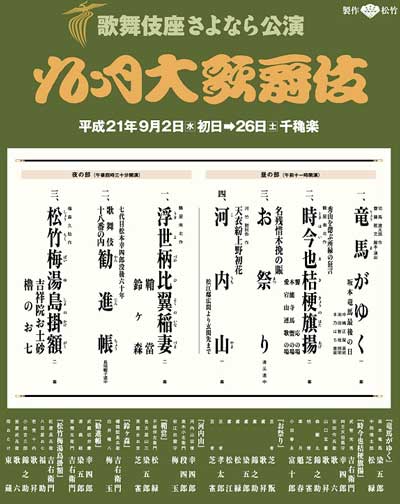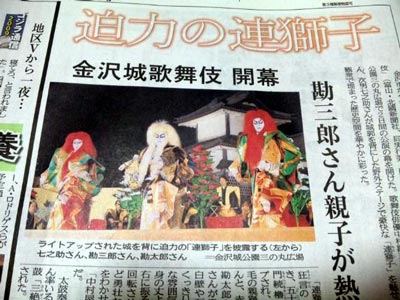| SEPTEMBER 2009 |
|
2 shows in T˘ky˘ (Kabukiza), 2 in Nagoya (Heisei Nakamuraza), 1 in Kanazawa (Kanazawaj˘) and 2 tours (Western Provinces, Zenshinza)!
|
|
|||
| Dates | 2 ~ 26 September 2009 (Kugatsu ďkabuki) Kabukiza Sayonara K˘en |
||
| MatinÚe |
Ry˘ma ga Yuku (Saigo no Ichinichi) |
||
| Evening |
|
||
| Casting |
Nakamura Kichiemon, Matsumoto K˘shir˘, Nakamura Shikan, Nakamura Tomijűr˘, Nakamura Shibajaku, Nakamura Baigyoku, Nakamura Kaishun, Kataoka Takatar˘, Nakamura Fukusuke, Ichikawa Danshir˘, Nakamura T˘z˘, Nakamura Kinnosuke, Ichikawa Somegor˘, Onoe Sh˘roku, Nakamura Karoku, Nakamura Kash˘, Nakamura Matsue |
||
| Comments |
9th of the 16 Kabukiza Sayonara K˘en, the Kabukiza Farewell Performances, which will be held up to April 2010.
|
||
 |
| Heisei Nakamuraza (Nagoya) | |
| Dates | 4 ~ 26 September 2009 |
| MatinÚe | |
| Evening |
Keisei Hangonk˘ (Domo Mata) |
| Casting |
Nakamura Kanzabur˘, Nakamura Hashinosuke, Nakamura Senjaku, Band˘ Yajűr˘, Kataoka Kamez˘, Sasano Takashi, Nakamura Kantar˘, Nakamura Shichinosuke |
| Comments |
The Heisei Nakamuraza is in Nagoya for the second time. The first time, it was a short stay as part of the long September 2006 tour in the western provinces. This time, it is a month-long project, with two different programs, including one classic of the Nakamuraya guild ("H˘kaib˘").
|
| Kabuki Tour in the western provinces | |
| Dates | 31 August ~ 25 September 2009 |
| Program |
Sakata T˘jűr˘ no Omemie (Goaisatsu) |
| Casting |
Sakata T˘jűr˘, Nakamura Kanjaku, Kataoka Ainosuke, Kataoka Hidetar˘, Band˘ Hikosabur˘, Nakamura Kikaku, Nakamura Kazutar˘ |
| Comments |
Chikamatsuza tour in the Western provinces:
|
| Zenshinza Tour | |
| Dates | 13 ~ 28 September 2009 |
| Program | |
| Casting |
Arashi Keishi, Kawarasaki Kunitar˘, Arashi Hironari, Anegawa Shinnosuke, Ikushima Kigor˘, Matsunami Kihachir˘ |
| Comments |
The Zenshinza troupe is on tour all over Japan: Source: Earphone Guide website |
 |
|
|
| Contact | Main | Top | Updates | Actors | Plays | Playwrights | Programs | Links | FAQ | Glossary | Chronology | Illustrations | Prints | Characters | Derivatives | Theaters | Coming soon | News |
